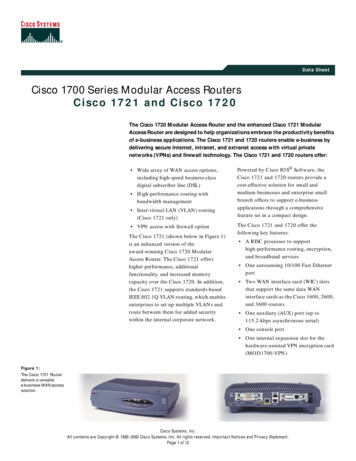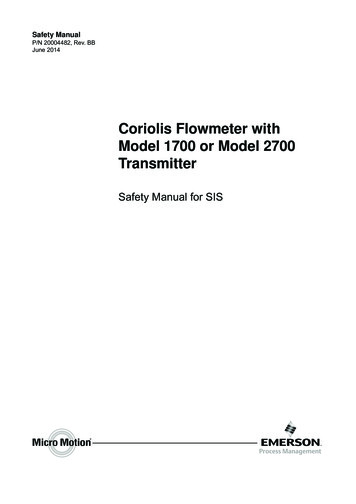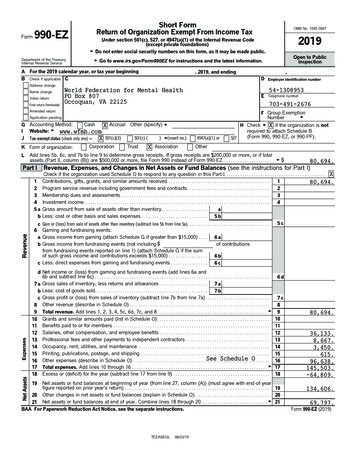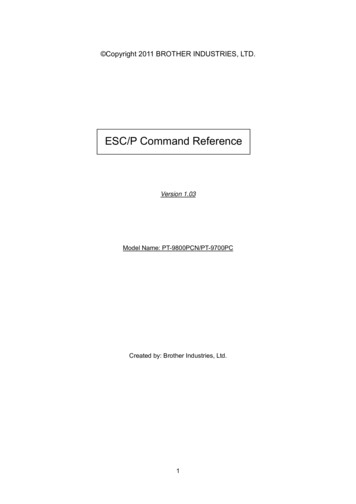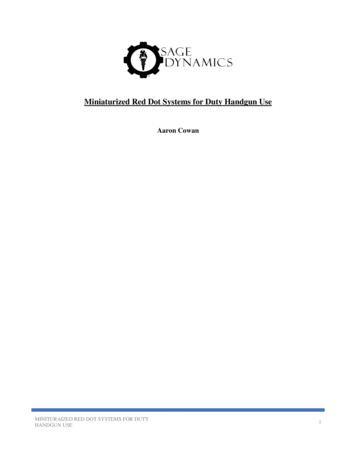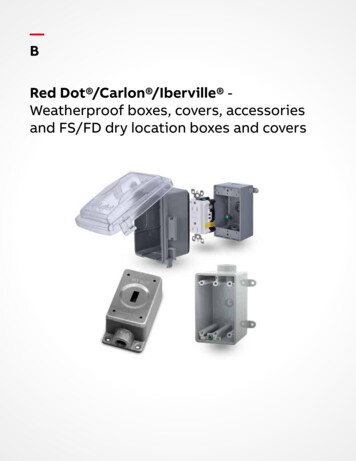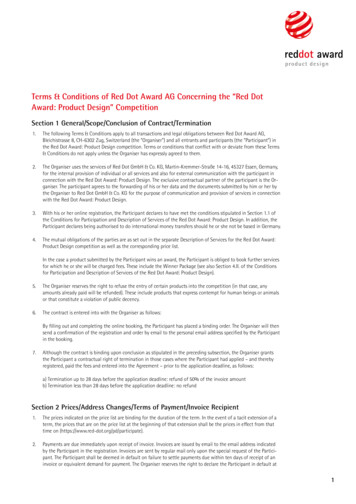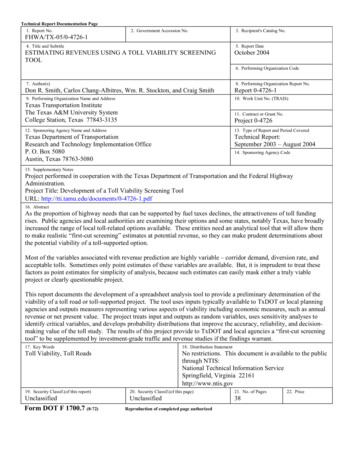
Transcription
Technical Report Documentation Page1. Report No.2. Government Accession No.3. Recipient's Catalog No.FHWA/TX-05/0-4726-14. Title and Subtitle5. Report DateESTIMATING REVENUES USING A TOLL VIABILITY SCREENINGTOOLOctober 20046. Performing Organization Code7. Author(s)8. Performing Organization Report No.Don R. Smith, Carlos Chang-Albitres, Wm. R. Stockton, and Craig SmithReport 0-4726-19. Performing Organization Name and Address10. Work Unit No. (TRAIS)Texas Transportation InstituteThe Texas A&M University SystemCollege Station, Texas 77843-313511. Contract or Grant No.12. Sponsoring Agency Name and Address13. Type of Report and Period CoveredTexas Department of TransportationResearch and Technology Implementation OfficeP. O. Box 5080Austin, Texas 78763-5080Technical Report:September 2003 – August 2004Project 0-472614. Sponsoring Agency Code15. Supplementary NotesProject performed in cooperation with the Texas Department of Transportation and the Federal HighwayAdministration.Project Title: Development of a Toll Viability Screening ToolURL: http://tti.tamu.edu/documents/0-4726-1.pdf16. AbstractAs the proportion of highway needs that can be supported by fuel taxes declines, the attractiveness of toll fundingrises. Public agencies and local authorities are examining their options and some states, notably Texas, have broadlyincreased the range of local toll-related options available. These entities need an analytical tool that will allow themto make realistic “first-cut screening” estimates at potential revenue, so they can make prudent determinations aboutthe potential viability of a toll-supported option.Most of the variables associated with revenue prediction are highly variable – corridor demand, diversion rate, andacceptable tolls. Sometimes only point estimates of these variables are available. But, it is imprudent to treat thesefactors as point estimates for simplicity of analysis, because such estimates can easily mask either a truly viableproject or clearly questionable project.This report documents the development of a spreadsheet analysis tool to provide a preliminary determination of theviability of a toll road or toll-supported project. The tool uses inputs typically available to TxDOT or local planningagencies and outputs measures representing various aspects of viability including economic measures, such as annualrevenue or net present value. The project treats input and outputs as random variables, uses sensitivity analyses toidentify critical variables, and develops probability distributions that improve the accuracy, reliability, and decisionmaking value of the toll study. The results of this project provide to TxDOT and local agencies a “first-cut screeningtool” to be supplemented by investment-grade traffic and revenue studies if the findings warrant.17. Key Words18. Distribution StatementToll Viability, Toll RoadsNo restrictions. This document is available to the publicthrough NTIS:National Technical Information ServiceSpringfield, Virginia 22161http://www.ntis.gov19. Security Classif.(of this report)20. Security Classif.(of this page)21. No. of PagesUnclassifiedUnclassified38Form DOT F 1700.7 (8-72)Reproduction of completed page authorized22. Price
ESTIMATING REVENUES USINGA TOLL VIABILITY SCREENING TOOLbyDon R. SmithAssociate ProfessorDepartment of Industrial EngineeringCarlos Chang-AlbitresGraduate Assistant ResearcherTexas Transportation InstituteWm. R. Stockton, P.E.Research Engineer and Associate DirectorTexas Transportation InstituteandCraig SmithAssistant Transportation ResearcherTexas Transportation InstituteReport 0-4726-1Project 0-4726Project Title: Development of a Toll Viability Screening ToolPerformed in cooperation with theTexas Department of Transportationand theFederal Highway AdministrationOctober 2004TEXAS TRANSPORTATION INSTITUTEThe Texas A&M University SystemCollege Station, Texas 77843-3135
DISCLAIMERThe contents of this report reflect the views of the authors, who are responsible for thefacts and the accuracy of the data presented herein. The contents do not necessarily reflect theofficial views or policies of the Federal Highway Administration (FHWA) or the TexasDepartment of Transportation (TxDOT). This report does not constitute a standard,specification, or regulation. The engineer in charge was Wm. R. Stockton, P.E., (Texas, #41188).IMPORTANT NOTE TO USERSThe spreadsheet tool developed in this research is based on the Decision Tools Suitefrom Palisade Corporation. Execution of this model requires purchase and installation ofPalisade Corporation’s Decision Tools suite of software containing the Microsoft Excel add-insimulation macros that interface with Excel. The Decision Tools suite of software (macros thatare loaded into Excel) must be installed on the user’s computer. To execute this model, the@RISK icon is selected. The loading process brings up Excel and installs the required macros.Then the model can be loaded similar to any other spreadsheet application.The United States Government and the State of Texas do not endorse products ormanufacturers. Trade or manufacturers’ names appear herein solely because they are consideredessential to the object of this report.v
ACKNOWLEDGMENTSThis document represents the investigative and analysis phase of a research projectinvolving the design, development, and testing of a static and simulation-based spreadsheetmodel to assist in the estimating of annual gross toll revenues and the equivalent net presentvalue of those gross revenue estimates over a 40-year study period.The authors appreciate the ongoing assistance and guidance of the project director, RoyJarbeaux, of the Corpus Christi District, Texas Department of Transportation, as well as inputfrom Diana Vargas and others in the Texas Turnpike Authority Division.Special thanks are also due to the various TxDOT divisions and districts who havegraciously contributed time and effort in providing test data and constructive feedback andreview of the project, the software, and all associated official documents relating to this effort,including Phillip Russell, TTA, Program Coordinator; Andrew Griffith, RTI, Research Engineerand the Project Advisors: Martha Boyd, ELP; David Powell, TTA; Clay Smith, SAT; and DanWyly, ISD.vi
TABLE OF CONTENTSPageImportant Note to Users. vList of Figures. viiiList of Tables . ixChapter 1: Introduction . 1Background . 1Purpose. 4Scope. 4Chapter 2: Background and Literature Review . 5Chapter 3: Important Terms and Concepts. 9Simulation . 9Variables . 9Certain or Uncertain. 9Independent or Dependent . 9Input/Output Variables. 9How Simulation “Works” . 10Application of the Triangular Distribution . 10Sensitivity Analysis and Tornado Diagrams. 14Using Travel Time Savings as a Basis to Estimate Initial Toll Rate . 15Base Toll Diversion Rates . 17Price Elasticity Estimates. 18Chapter 4: Overview of the Model . 21Overview of the Model . 21Key Elements of the Model . 22Inputs. 23Outputs. 24Closing Remarks. 24References. 27vii
LIST OF FIGURESPageFigure 1.Figure 2.Figure 3.Figure 4.Figure 5.Figure 6.Example of a Triangular Distribution to Estimate ADT. . 12Tornado Diagram to Visualize the Results of Sensitivity Analysis. . 15Specimen Data Entry for Toll Diversion Rates-Two-Axle Vehicles. . 18Data Input for Price Elasticity. . 19Calculated Elasticity Parameter. 20Overview of the Model’s Logic. . 21viii
LIST OF TABLESPageTable 1. Recommended Elements of Toll Feasibility Study (2). 5ix
CHAPTER 1:INTRODUCTIONAs the proportion of highway needs that can be supported by fuel taxes declines, theattractiveness of toll funding rises. Public agencies and local authorities are examining theiroptions and some states, notably Texas, have broadly increased the range of local toll-relatedoptions available. These entities need an analytical tool that will allow them to make realistic“first-cut screening” estimates at potential revenue, so they can make prudent determinationsabout the potential viability of a toll-supported option.Most of the variables associated with revenue prediction are highly variable – corridordemand, diversion rate, and acceptable tolls – and can increase in variability with the length ofthe project. Sometimes only point estimates of these variables are available. But, it is imprudentto treat these factors as point estimates for simplicity of analysis, because such estimates caneasily mask either a truly viable project or clearly bad project.This report documents the development of a spreadsheet analysis tool to provide apreliminary determination of the viability of a toll road or toll-supported project. The tool usesinputs typically available to TxDOT or local planning agencies; it outputs measures representingvarious aspects of viability including economic measures, such as annual revenue or net presentvalue. The project treats inputs and outputs as random variables, uses sensitivity analyses toidentify critical variables, and develops probability distributions that improve the accuracy,reliability, and decision-making value of the toll study. The results of this project provide toTxDOT and local agencies a “first-cut screening tool,” to be supplemented by investment-gradetraffic and revenue studies if the findings warrant.BACKGROUNDToll financing of highway projects is becoming increasingly attractive in Texas. Currentfunding sources will support a declining proportion of the needs identified by the TexasDepartment of Transportation (TxDOT). Funding requirements for maintenance andconstruction continue to grow, while increasing fuel efficiency reduces fuel-tax revenues pervehicle-mile. In the face of growing financial limitations, the Texas Legislature has providedtolling options that are broader than ever in Texas.1
The Texas Legislature has created the authority for regions to form Regional MobilityAuthorities (RMAs) for the purpose of developing toll-supported highways where adequate localor state funding is not available. These RMAs may establish toll-supported facilities when sucha facility is viable. Because the RMAs are not well-established toll authorities, the fundsavailable to conduct toll-feasibility studies will be limited. Therefore, these new authorities needsome capability to estimate, at least roughly, the feasibility of toll support for a prospective roadproject.Similarly, the potential for toll support of state highways is receiving considerableattention within TxDOT. In the 1990s, TxDOT and the North Texas Tollway Authority (NTTA)coordinated to complete the President George Bush Turnpike (SH 190) in north Dallas. TxDOThad taken the project through design, environmental clearance, and right-of-way acquisitionwhen it was transferred to NTTA. The vast majority of the 1 billion project was financedthrough bond sales, but the funding package also included a 135 million Intermodal SurfaceTransportation Efficiency Act of 1991 (ISTEA) loan through TxDOT. This type of “toll equity”financing has generated considerable interest and is envisioned as a likely model for some stateprojects and many potential RMA projects. Like the RMAs, the Texas Turnpike Authority(TTA) division of TxDOT does not have cash income to support numerous feasibility studies,but could benefit significantly from having sound analytical insight into the approximateviability of a toll project. That kind of analysis would allow TxDOT and the RMAs to answertwo key questions: Is there a reasonable likelihood that a project will be self-supporting as a toll road? If not, what is the expected level of available toll support to use as a match foravailable public funds?The genesis for the proposed project arose out of a specific TxDOT Houston Districtneed. That need highlighted the potential value of a user-friendly toll viability screening tool. In2002 TxDOT asked the Texas Transportation Institute (TTI) to examine a section of SH-99 (theGrand Parkway) near Houston to assess the feasibility of converting that facility to a toll road. Atechnical memorandum detailing the findings of that study concluded that toll revenues wouldsupport about 20 percent of the total project cost (1). That brief study was conducted in a matterof a few weeks, but because it was unlike any previous work, it required considerable originalwork, especially in piecing together existing data to estimate potential traffic volumes and toll2
revenues. That study concluded that the debt coverage ratio for the proposed project was likelywell below 0.5, making the project a most unlikely candidate for a toll road. At the time,TxDOT was not considering the project for toll equity financing, so that potential fundingalternative was not explored. So, while a “go/no go” decision on a self-sustaining toll road waseasily made using the data and tools available, the potential as a toll equity project was not nearlyso easily concluded.Having the capability to examine the toll viability question in a rapid turnaround mannerwould allow TxDOT to make very expeditious decisions about what role tolls should play in theproject. This situation also demonstrated the potential value of TxDOT having an in-housecapability to make a first-cut assessment of toll viability. But it also illustrated a vulnerability ofthese studies – dependence on point estimates of traffic volumes, diversion rates, and tollrevenues.Because toll road construction is funded (at least primarily) by the proceeds of revenuebonds, investors (purchasers of the bonds) want to be comfortable that the estimated revenueswill be sufficient to service the debt of the bonds. Expertise to conduct “investment-grade”traffic and revenue studies, in which bond houses place considerable confidence, resides in asmall handful of engineering consulting firms. Over the course of many years, these firms havedeveloped capabilities and techniques that accord their analyses the level of confidence thatmajor bond houses seek – that closely held expertise is not likely to change soon, certainly notwith the outcome of the proposed research. The cost of an investment grade feasibility analysis ishigh enough, so there must be a good likelihood of feasibility before one is commissioned.However, before TxDOT or any other entity can pursue an investment-grade project,there needs to be some analysis that indicates the role that tolls can play in a project. The TTIproject referenced above used fairly simple spreadsheet models to estimate toll road costs andrevenues, and thus predicted the potential viability of tolling that segment of the SH-99.Highlighted by that study were a few variables that are subject to considerable assumption(s) inthe toll feasibility analysis. If those assumed values for these variables could be replaced withmuch more reliable probability distributions, then the results would be much more reliable andvaluable.3
PURPOSEThis spreadsheet tool is intended to allow the user to develop a reliable estimate of thetoll revenue potential of a highway project. It allows for a comparison of revenues with expectedcosts, either as a net present value (NPV) for the project or on an annual basis. This latter featureis important for the obvious reason that bond repayment requires that a toll project cover debtservice within a few years. But some of the other innovative funding techniques beingconsidered by TxDOT, such as using toll revenues to pay for maintenance and operations,instead of capital costs, also require some level of understanding of annual revenues.This tool complements TxDOT’s existing methods, including the Preliminary FeasibilityTool (PFT) released in mid-2004. The PFT performs many functions that complement the tollviability screening tool (TVST), such as cost estimates and estimates of potential bond funding.The TVST complements the PFT by increasing the reliability of the preliminary revenueestimates.SCOPEThe toll viability screening tool is applicable to all highway toll projects, though some ofthe input variables will change significantly depending on setting. For example, an urban projectwith similar toll projects in the region will differ considerably from a suburban project in theregion with no toll roads, mostly because so little is known about the range of variability ofpublic tolerance for tolling.The scope of the more advance techniques imbedded in the tool is limited to revenueprojections. Theoretically, the estimating principles that apply to revenues could be applied tocosts as well. However, TxDOT has extensive experience in estimating costs so the efforts ofthis project were focused on revenues.4
CHAPTER 2:BACKGROUND AND LITERATURE REVIEWIn the mid-1990s, TTI prepared a series of reports for TxDOT that developed anevaluation procedure for the feasibility of private toll roads. Anticipating increased interest inprivately funded toll roads for which TxDOT was responsible for evaluating and recommendingto the Texas Transportation Commission, TxDOT wanted a uniform procedure for the evaluationprocess. In the final report, Glenn identified the following elements for the suggested guidelines(only major headings shown) (2) (Table 1):Table 1. Recommended Elements of Toll Feasibility Study (2).Project Description and Proposed AlignmentIntegration with Existing Transportation PlansEnvironmental ImpactsTraffic ForecastsFinancial PlanEconomic ImpactsImpact on U.S. – Mexico Trade FlowSensitivity AnalysisGlenn’s variables included the complete range of expenses for the life cycle of theproject. The results of his analyses will be helpful to the proposed project, as the generalconditions of feasibility should be consistent between privately and publicly funded tollinvestments. Further, his analyses of the levels of sensitivity of dependent variables provide asound starting point for the toll viability study.Toll revenues are a function of toll road traffic volumes and toll rates. While accuratelypredicting traffic volume on a “free” (actually tax-funded) road is difficult, estimates for tollroads are much more challenging because of the impact of the tolls themselves. In general, topay a toll, the traveler must perceive a benefit that is greater than the price of the toll itself.Travel time savings is typically used as a measure of benefit to most travelers. The monetarytrade-off decision made by the traveler is: “Is the savings in time sufficient to justify the tollpaid?” If the traveler perceives that the benefit is less than the toll paid, then he or she will usean alternative rather than the toll facility.One approach to estimating that benefit is to multiply the “value of time” by the traveltime saved, producing a monetary value – if that value is greater than the toll paid, then thetraveler would use the toll road. However, the value of time is a distribution rather than a single5
value. Trip purpose, length of trip, available alternatives, total time savings, travel timereliability, disposable income, and other factors contribute to this distribution of value of time,making point estimates of potential revenues of limited worth. A model for estimating tollviability should be based on appropriate distributions of the value of time, without requiring theuser to make complex decisions or calculations of the variables described above.The importance of other, less direct factors cannot be overlooked. For example, theSR-91 Express Lanes in Orange County, California, experience toll road use that is notinsignificant during times of day when the adjacent free lanes are operating in free-flowconditions (3). The operating staff concludes that factors other than pure travel time savingscontribute to the travelers’ decisions to use the toll lanes, such as perceived improved safety andmuch higher travel time reliability.Projected traffic volumes throughout the life of the typical revenue bond road project (2030 years) are subject to substantial variability. Well-developed regional planning modelsprovide an estimate of roadway volumes at various time horizons, but those estimates aretypically point estimates of the expected mean traffic volume. Further, the planning models donot typically provide any confidence intervals that describe to the analyst or decision makersome sense of how broadly distributed the expected volumes might be, and this variation couldbe a significant factor in decision-making.Li et al. used stated preference surveys of travelers on I-635 and the Dallas NorthTollway to develop estimates of price elasticity of demand (4). The situational context of thisstudy is different from most potential RMA projects, but in principle represents similar factors –drivers are choosing (in a survey) between a non-toll trip and a faster, more reliable toll trip.From their study, the authors conclude that the deduced value of time is between 3 and 6,considerably below any local wage rate, suggesting that other factors play a significant role inthe traveler’s decision to use a toll facility. The project developed a toll evaluation tool, basedon some assumed and empirical estimates of driver response to toll and time savings. Theauthors conclude that the tool has promise, but requires additional refinement. As with the otherprevious research, the results of the Dallas study provide an excellent starting point for theproposed research.Thus the estimation of toll revenues, as a function of volumes and tolls, is actually acomplex interaction of traffic, travel time savings, value of time, and tolls, each with its own6
distribution and each interacting with one or more other variables. Although the interaction iscomplex, it produces a much more robust result for decision-making, and appropriate applicationof background probability distributions makes task of making reasonable estimates of tollrevenues straightforward.A 1998 study by Orozco and McCullough examined the experience of the broaddevelopment of toll facilities in Mexico during the 1990s, with a goal of improving the accuracyand reliability of estimating the variables that affect gross toll revenues (5). The study developeda traffic forecasting model based on travel distance, travel time, and user costs, but unlike Glenn,limited the variables considered. Using the empirical data from the developed toll roads todescribe elasticity, the authors prepared adjustments to the mathematical functions for trafficforecasting. They noted that usage, and therefore toll revenues from passenger cars, wasconsiderably more elastic than for trucks, which had generally lower diversion rates than carsand buses. Although the study was based on a limited sample of Mexican toll roads, theprinciples and mathematical relationships developed will be another useful element of theproposed study.7
CHAPTER 3:IMPORTANT TERMS AND CONCEPTSSIMULATIONSimulation is the art and science of moving a defined modeled system through time inorder to observe and record changes manifest by risk and uncertainty. Simulation is a statisticalprocess that generates artificial data from a model and displays the summary data in ameaningful format.VARIABLESVariables are the basic elements of a model that hold important values that make up ordescribe the situation being modeled. Users define variables, but the software program holds celllocations at their assumed values.CERTAIN OR UNCERTAINIf a given variable is known with a high degree of confidence, that variable is termed“deterministic.” If the variable in question can assume a range of values not expertly known tothe decision maker, that variable is termed “stochastic” or “uncertain.” If a variable is stochasticin nature, the user will assign a reasonable probability distribution to model the possible outcomeof that variable for a given iteration of the model. For the model described herein, users candefine stochastic variables by placing an assumed distribution function in a cell.INDEPENDENT OR DEPENDENTIndependent variables are unaffected by the values that other variables assume within amodel. A dependent variable is a variable whose value is determined by one or more of the othervariables defined in the model. Dependent variables change within the model as the othervariables change.INPUT/OUTPUT VARIABLESAny model requires the combination of input variables, which in turn determine the valueof output variables. Output variables represent variables that are of keen interest to the decision9
maker and will change with changes in one or more of the variables that define the outputvariable.HOW SIMULATION “WORKS”Simulation works by selecting values for all of the variables that are assumed to beuncertain in nature and calculating an outcome for one or more of the output variables of interestand storing the value. This is termed an iteration. Then another iteration is performed,recalculating the stochastic variables and saving the result for the designated output variable.Any reasonable number of iterations can be performed, and the resultant value of the outputvariable is saved in a temporary file. At the conclusion of the simulation, all of the resultantvalues of the output variable can be viewed either in tabular or graphical form.For the model presented herein, a simulation software package from Palisade Corporationis used in conjunction with Excel. The specific software package is termed “@RISK” and is aset of pre-written macros that load into Excel. It is then possible to define a given cell withinExcel to be a probability distribution. Currently, @RISK supports over 25 different probabilitydistributions and possesses unique and powerful capabilities to graphically display resultsrelating to the designated output variables.Application of the Triangular DistributionThe important concept built into the simulation model is that the analyst inputs threevalues for the input parameters for this section. As discussed in the Introduction, the objective ofthis project was to construct a simulation model that assumes that relevant input parameters aretreated as random variables. With this point in mind, the current version of the model is basedon a relevant probability distribution that represents a reasonable operating definition of most ofthe input variables. The current simulation model describes many of the input variables by atriangular distribution.The triangular distribution requires three input values from the analyst: a minimumperceived value, a mean value, and a maximum value. Rather than inputting a single value(representing a point estimate or a constant) the analyst suggests a range of values from a lowvalue, an average value, and a maximum value. The current model makes extensive us
triangular distribution, as it represents a reasonable distribution to represent input values. There are other candidate distributions that could be applied, but this model is restricted to the triangular distribution. Equation (1) gives the probability distribution function for the triangular distribution: 2( ) ()( ) xa fx bac a .

